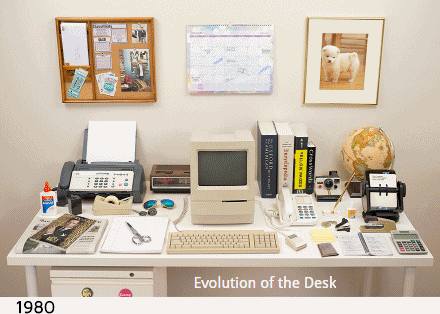I saw today the blog by Michael Kroker pointing to the evolution of the digital experience at a typical desk.
Source: Best Reviews (Animation) and Tim Weber (GIF)
It’s quite impressive how physical assets like books, calendars, cameras, fax machines, …, are just replaced one after the other by apps. Everybody perceives this evolution in a different way. Some people enjoy it, some feel threatened, some just don’t realize it. Here’s my personal point of view:
- Devices consolidate and become multi-purpose. Multiple devices like the fax machine, the phone, the camera, the radio consolidate basically into a few remaining devices. One for each form factor – not for each purpose. One laptop, one smartphone, maybe one tablet in between or an additional smart watch. Each of these devices is multipurpose, based on many apps.
- Everything is in the cloud. All these apps show on your remaining devices the consistent content! Obviously the consumer space with less privacy concerns is ahead, but the private experience raised an enormous pressure to enterprise apps showing the same data ubiquity and hence moving to the cloud as well.
- Our life becomes asset light. While many people traveled to their office every day, today’s millennials have one of their smart devices everywhere. This leads to liquid working concepts or the anywhere worker phenomena, that cloud services like Circuit.com also support for secure business collaboration.
As always with the analysis of the mega trends like the digitalization of the society, it is even more interesting to look forward, than just understanding what happened in the past. Following the above analysis of the past, we should not only wonder what we DO in the future, but even more what we will NOT DO ANYMORE in the near or far future. If the characteristics above continue to be a guiding principal, I can imagine that digitalization continues like this:
- The Internet of Things (IoT) grows much faster in the private than in the industrial space. Although realizing the massive initiatives in Germany around Industrie 4.0 and similar industrial IoT projects globally, many IoT scenarios must rely on the cloud to make the data ubiquitous. Therefore IoT consumer clouds, like the automotive vendors’ connected car backbones, grow much faster in adoption than their counterparts in the B2B world.
- More assets become digital. I remember already back at CeBit 1999, when I was with the German e-Commerce start-up Intershop, we showed a fridge that automatically ordered new food based on the scanned items you removed. Now, 17 years later, the average fridge is still not connected. However light bulbs are online, what we didn’t expect in the past. The industry will simply try to digitalize more assets with technology like the low cost, low bandwidth connections (like Sigfox). The more we try, the more will succeed. In the future, assets become digital, that we do not expect to be connected at all today.
- Devices move from multi-purpose devices to multi-form factor devices. If you hold a big iPad-Pro with the mounted keyboard and the pen, it’s quite a clumsy and heavy device trying to merge the laptop and the tablet. However, emerging technology like an foldable display (see Nokia example) or an build-in projected keyboard (currently as a add-on device) will enable the further consolidation of devices. A smart watch can fully replace your smart phone, an light tablet can fully replace the laptop and so on, if they manage to address multiple form-factors at the same time.
There are many other things, we are used to today, but we don’t do any more in the future. I could imagine that in 25 years my grand kids (hope to have one by then) might say, Opa, isn’t it to dangerous to stier your car on your own…
Have fun at CeBit 2016 and envision the future.
You’ll find me at the Unify booth, hall 13, D40
Stefan

